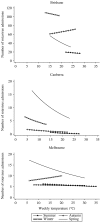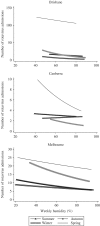Climatic factors associated with hospitalizations for rotavirus diarrhoea in children under 5 years of age
- PMID: 17352836
- PMCID: PMC2870768
- DOI: 10.1017/S0950268807008229
Climatic factors associated with hospitalizations for rotavirus diarrhoea in children under 5 years of age
Abstract
This study compares the seasonality of rotavirus diarrhoeal hospital admissions and its relationship to climatic factors across three Australian cities. Weekly admission of rotavirus diarrhoea (1993-2003) in children aged <5 years and weekly average temperature and relative humidity for each city were modelled using a log-linear model with a cubic trend and season. Interactions were included to test for differences in the effect of temperature and humidity between seasons and between cities. Admissions of rotavirus diarrhoea peaked in winter and spring and were lowest in summer. Higher temperature and humidity in the previous week were associated with a decrease in rotavirus diarrhoeal admissions in three cities. The effects of both temperature and humidity on rotavirus admissions in Brisbane differed across seasons. Strategies to combat outbreaks of rotavirus diarrhoea should take climatic factors and seasonal effects into consideration to plan for the excess seasonal hospital admissions.
Figures




Similar articles
-
Structured surveillance of infantile gastroenteritis in East Anglia, UK: incidence of infection with common viral gastroenteric pathogens.Epidemiol Infect. 2008 Jan;136(1):23-33. doi: 10.1017/S0950268807008059. Epub 2007 Feb 21. Epidemiol Infect. 2008. PMID: 17313697 Free PMC article.
-
Effects of short-term exposure to air pollution on hospital admissions of young children for acute lower respiratory infections in Ho Chi Minh City, Vietnam.Res Rep Health Eff Inst. 2012 Jun;(169):5-72; discussion 73-83. Res Rep Health Eff Inst. 2012. PMID: 22849236
-
[Infectious diarrhoea in children under five years].Tunis Med. 2009 Sep;87(9):599-602. Tunis Med. 2009. PMID: 20180381 French.
-
Epidemiology of rotavirus diarrhoea in Africa: a review to assess the need for rotavirus immunization.Bull World Health Organ. 1998;76(5):525-37. Bull World Health Organ. 1998. PMID: 9868844 Free PMC article. Review.
-
Rotavirus: the first five years.J Pediatr. 1980 Apr;96(4):611-22. doi: 10.1016/s0022-3476(80)80725-6. J Pediatr. 1980. PMID: 6244380 Review. No abstract available.
Cited by
-
A systematic review and meta-analysis of the global seasonality of norovirus.PLoS One. 2013 Oct 2;8(10):e75922. doi: 10.1371/journal.pone.0075922. eCollection 2013. PLoS One. 2013. PMID: 24098406 Free PMC article. Review.
-
Hospital-based surveillance to estimate the burden of rotavirus gastroenteritis in children below five years of age in Romania.Germs. 2014 Jun 2;4(2):30-40. doi: 10.11599/germs.2014.1053. eCollection 2014 Jun. Germs. 2014. PMID: 24967217 Free PMC article.
-
Associations between meteorological variation and hospitalisations for rotavirus infections in Kuala Lumpur, Malaysia.Heliyon. 2024 Mar 26;10(7):e28574. doi: 10.1016/j.heliyon.2024.e28574. eCollection 2024 Apr 15. Heliyon. 2024. PMID: 38596105 Free PMC article.
-
Exploration of diarrhoea seasonality and its drivers in China.Sci Rep. 2015 Feb 4;5:8241. doi: 10.1038/srep08241. Sci Rep. 2015. PMID: 25649629 Free PMC article.
-
Are hospitalizations for rotavirus gastroenteritis associated with meteorologic factors?Eur J Clin Microbiol Infect Dis. 2014 Sep;33(9):1547-53. doi: 10.1007/s10096-014-2106-y. Epub 2014 Apr 24. Eur J Clin Microbiol Infect Dis. 2014. PMID: 24760250
References
-
- D'Souza R et al. Climatic factors association with hospitalisation and emergency room presentations of diarrhoea. Epidemiology. 2005;16:S60.
-
- Carlin JB et al. Rotavirus infection and rates of hospitalisation for acute gastroenteritis in young children in Australia, 1993–1996. Medical Journal of Australia. 1998;169:252–256. - PubMed
-
- Ferson MJ. Hospitalisations for rotavirus gastroenteritis among children under five years of age in New South Wales. Medical Journal of Australia. 1996;164:273–276. - PubMed
-
- Matson DO, Estes MK. Impact of rotavirus infection at a large pediatric hospital. Journal of Infectious Diseases. 1990;162:598–604. - PubMed
-
- Spence L et al. Rotavirus infection in children with diarrhoea admitted to a general hospital in Metro Toronto. Canadian Journal of Public Health. 1985;76:17–20. - PubMed

